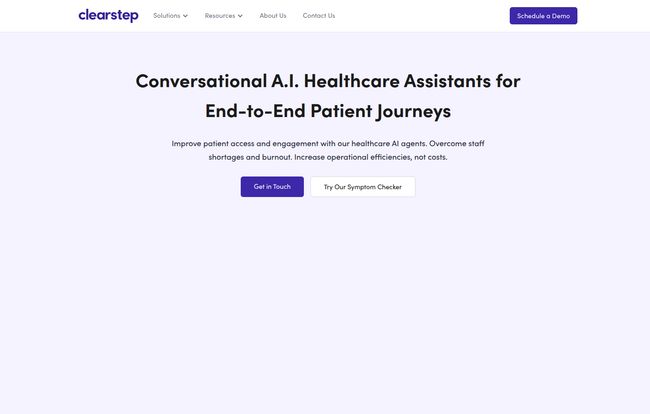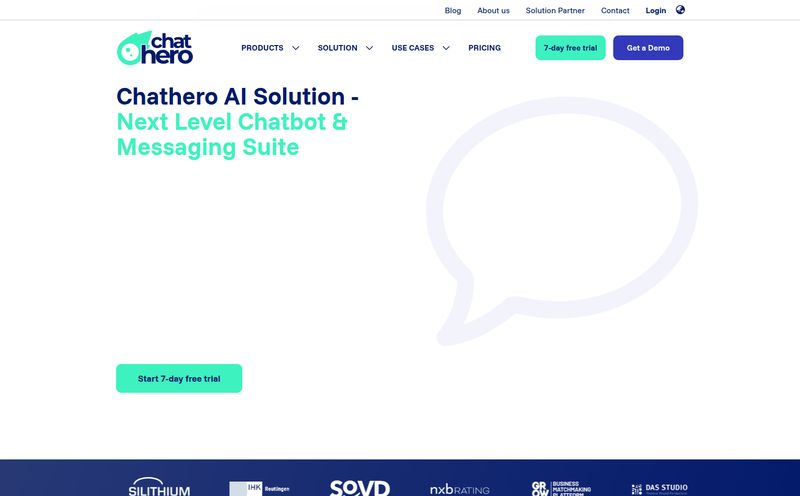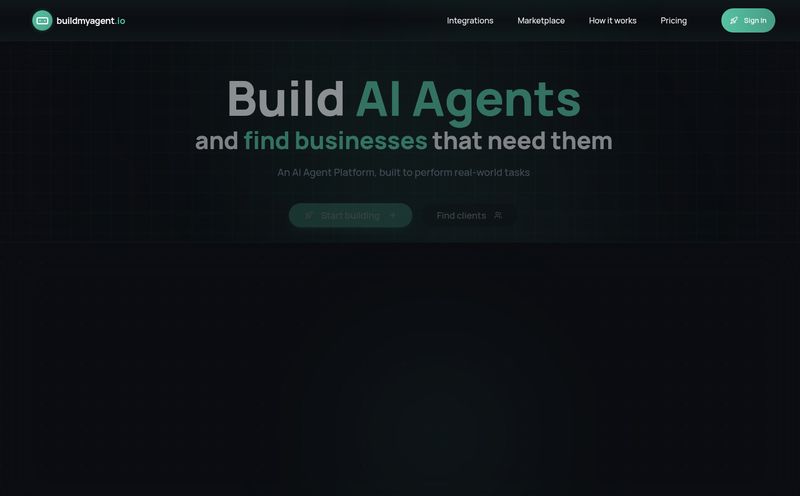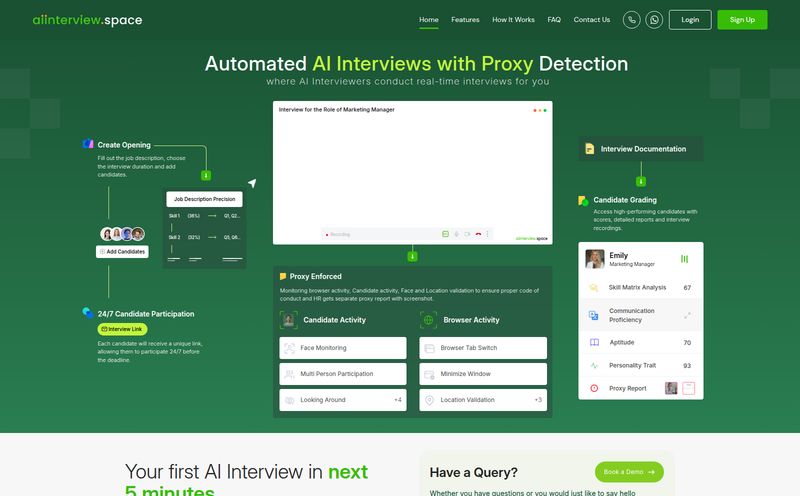How many times have you found yourself lost in the labyrinth of healthcare scheduling? You call your doctor’s office, get put on hold, listen to some truly awful hold music, and then finally get a human who tells you the next available appointment is in six weeks. Or maybe you've played the fun game of “Is this an emergency room thing, an urgent care thing, or a 'wait-it-out-and-see' thing?” at 2 AM.
It’s a universally frustrating experience. As someone who spends their days neck-deep in user experience, traffic generation, and engagement metrics, I can tell you that the healthcare industry's 'digital front door' has historically been… well, more like a brick wall.
That's why when I stumbled upon Clearstep, my professional curiosity was piqued. They’re making some bold claims about using “Conversational AI Healthcare Assistants” to guide patients, streamline everything, and basically unsnarl the tangled mess of patient access. But is it just more tech jargon, or is there real substance here? I decided to dig in.

Visit Clearstep
So What Is Clearstep, Really?
Okay, cutting through the marketing speak. At its core, Clearstep is an AI-powered platform designed to be the new front door for a hospital or healthcare system. Think of it less as a simple chatbot and more as a super-intelligent, always-on receptionist, triage nurse, and scheduler all rolled into one. It lives on a provider’s website or app and interacts with patients in a natural, conversational way.
Instead of a patient doom-scrolling WebMD and convincing themselves they have a rare tropical disease, they can interact with Clearstep’s AI. It asks them about their symptoms, and based on their answers, it doesn't just give them a scary list of possibilities. It guides them to the right kind of care—whether that's a telehealth visit, an appointment with a specialist, a trip to urgent care, or just some advice for at-home care. It's an air traffic controller for patients, and frankly, it's about time.
The Nuts and Bolts: How It Actually Works
Clearstep isn't just one thing; it's a suite of tools that work together. From what I can gather on their site, it breaks down into a few key areas.
The Smart Access Suite: Your Digital Triage Nurse and Scheduler
This is the patient-facing magic. It starts with the Virtual Triage, which is essentially their AI Symptom Checker. I’ve seen a lot of these over the years, and most are clunky. Clearstep's angle seems more sophisticated, claiming to be built on a massive clinical content library. It’s designed to accurately assess a patient's needs and then—this is the important part—seamlessly connect them to the next step using its Care Navigation and scheduling features. It checks provider availability, the patient's insurance, and location to find the best fit. This eliminates that horrible disconnect where a tool tells you what you need but then leaves you to figure out how to get it.
Optimizing the Back End for Hospital Capacity
This is the part that gets the hospital administrator in me excited. Clearstep isn't just a shiny toy for patients; it's a powerful tool for operations. Their Capacity Optimization Suite helps healthcare systems manage their most precious resource: provider time. It can intelligently manage schedules, fill last-minute cancellations from an automated waitlist, and reduce no-shows. In the world of healthcare, empty appointment slots are just lost revenue. By enhancing patient flow, Clearstep is directly aiming at the bottom line.
The Secret Sauce: Seamless Integration
Here’s what really makes a platform like this sink or swim. Integration. A tool can have the smartest AI in the world, but if it doesn’t talk to a hospital's existing systems, it’s useless. Clearstep seems to understand this deeply. They list integrations with the heavy hitters of the Electronic Health Record (EHR) world—we're talking Epic, Cerner, athenahealth, and others. This means the AI isn't just guessing; it's pulling real-time data from the system of record. That’s a game-changer. It means a patient can be scheduled directly into the doctor's calendar without a human having to manually transfer the information. Huge.
Why a Healthcare System Should Actually Care
So, the tech is cool. But what are the tangible benefits? Looking at their case studies and customer list (which includes big names like HCA Healthcare and Tufts Medicine), the value proposition becomes pretty clear. It's not just about a better patient experience, it's about making the whole operation more efficient. You’re looking at reduced administrative burden on staff, who can now focus on more complex patient needs instead of playing phone tag. This leads to improved operational efficiencies across the board. Plus, by guiding patients to the right care at the right time and making booking so simple, you naturally enhance patient flow and, you guessed it, increase revenue. Offering 24/7 medical support and guidance without hiring a massive call center staff is a massive win for any CFO.
Okay, Let's Be Real: The Potential Hiccups
Now, I’ve been in this game long enough to know there’s no magic bullet. Every powerful tool comes with its own set of challenges. For Clearstep, the first hurdle is right there in its biggest strength: integration. Connecting a new system to a deeply entrenched EHR like Epic is a major IT project. It requires time, resources, and a dedicated team. It's not a plug-and-play solution for a small private practice; it's an enterprise-level commitment.
There's also the reliance on the AI itself. While it's backed by clinical data, you're still placing a lot of trust in an algorithm to make the right initial call. The system is only as good as the AI's accuracy and the quality of the information the patient provides. We've all seen AI get things hilariously wrong, and in healthcare, the stakes are obviously much higher.
The Million-Dollar Question: Clearstep's Pricing
Alright, let's talk cost. I clicked on their 'Pricing' link in my research and... landed on a 404 page. Classic. This isn't a knock against them, actually. It's extremely common for enterprise-level B2B SaaS platforms like this. There’s no “one-size-fits-all” price tag.
Pricing for a tool like Clearstep will almost certainly be customized based on factors like:
- The size of the healthcare system
- The number of patients or interactions
- The specific modules you need (Triage, Scheduling, etc.)
- The complexity of the EHR integration
Your only path to a number is to hit that “Request a Demo” button and talk to their sales team. Don’t expect a simple monthly fee; this is a significant investment.
Frequently Asked Questions About Clearstep
What exactly does Clearstep do?
Clearstep provides an AI-powered conversational platform for healthcare providers. It acts as a virtual assistant to help patients check their symptoms, guides them to the appropriate level of care (telehealth, in-person, etc.), and schedules appointments directly into the provider's system.
Is Clearstep's AI symptom checker accurate?
According to Clearstep, their virtual triage tool is built by clinicians and is based on a vast library of clinical data, including the Schmitt-Thompson protocols, which are widely used in telephone triage. While no AI is perfect, it’s designed to be a safe and reliable first step in a patient's care journey.
Does Clearstep integrate with my current EHR system?
It’s very likely. Clearstep advertises seamless integrations with major EHR systems like Epic, Cerner, eClinicalWorks, and athenahealth, among others. This is one of their main selling points, as it allows for real-time, accurate scheduling and data flow.
Is Clearstep HIPAA compliant?
Yes. As a tool that handles protected health information (PHI), Clearstep is built to be HIPAA compliant, ensuring that all patient data is handled securely and privately.
How does Clearstep improve patient flow?
By automating the initial stages of the patient journey—symptom checking, care navigation, and scheduling—Clearstep frees up administrative staff. It also helps manage schedules more effectively, filling last-minute cancellations and reducing no-shows, which keeps the entire system moving more smoothly.
So, how much does it cost?
There's no public pricing. Clearstep uses a custom pricing model typical for enterprise software. You'll need to contact them for a demo and a quote based on your organization's specific needs.
My Final Take
After digging in, I'm genuinely impressed with what Clearstep is trying to do. They aren't just building another chatbot; they’re trying to build a new central nervous system for patient intake and management. The focus on deep EHR integration and measurable operational outcomes (like increased revenue and efficiency) shows they understand the business of healthcare, not just the tech.
Is it a perfect solution for everyone? No. It’s a serious tool for serious healthcare systems willing to invest in overhauling their digital front door. But in an industry crying out for innovation and a better user experience, Clearstep feels like a significant, and very necessary, step in the right direction. It might just be the AI that finally gets you an appointment without the headache… or the hold music.



